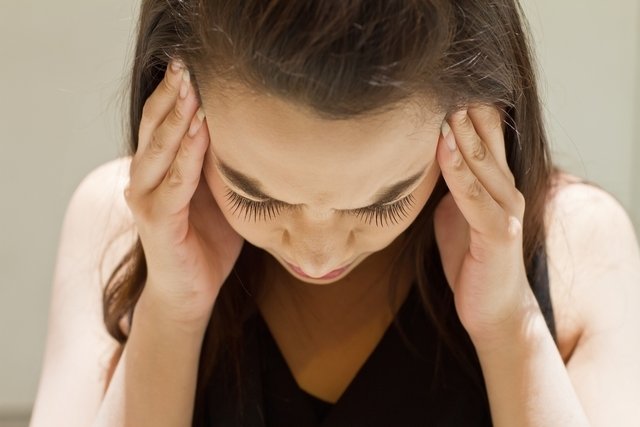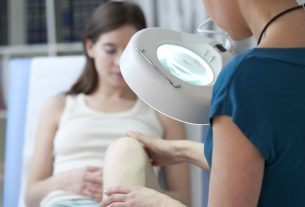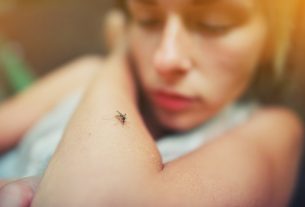Migraine is a chronic neurological condition that causes moderate to severe headache, as well as other symptoms such as general malaise, nausea, vomiting, tingling in the body and sensitivity to light.
Migraine pain is more common in women and, although it can appear as early as childhood, it is more common in adulthood. Migraines can appear at any time, but tend to be stimulated by specific situations, such as sleeping poorly, having PMS or having eaten some type of food.
Migraines are different from common headaches, having different causes and specific characteristics. See the main types of headache, how to identify and treat each one.

Main symptoms
The main symptoms of migraine are:
- Intense and throbbing headache;
- Pain on only one side of the head, in most cases.
- General malaise;
- Nausea and vomiting;
- Dizziness;
- Tingling in the body;
- Sensitivity to light and/or noise.
Migraine pain usually lasts for several hours, worsens with body movement and radiates to the face and neck, which ends up making daily activities difficult.
Some people may also show signs that a migraine attack is coming. These signs appear 1 to 2 days before the crisis and, although they may vary from one person to another, they generally include cravings for a specific food, excessive tiredness without an apparent cause, irritability or a stiff neck. Learn more about migraine symptoms.
Migraine with aura
Migraine with aura is a situation that can appear a few minutes before the classic symptoms and is characterized by changes in vision, such as the presence of a whitish cloud and even small bright spots in the field of vision. In some cases, migraines with aura can occur without the person experiencing the pain characteristic of migraines. See more about migraine with aura.
Chronic migraine
Chronic migraine is a relatively rare situation in which the symptoms of a migraine attack persist for more than 15 days. Although it is not life-threatening, chronic migraines can seriously affect daily activities and quality of life, which is why treatment with a neurologist should be carried out to alleviate symptoms. Learn more about chronic migraines.
Online symptom test
To find out the possibility of having a migraine, please indicate the symptoms you present below:
This test is a tool that serves as a means of guidance only. Therefore, it is not intended to provide a diagnosis or replace consultation with a neurologist or general practitioner.
Migraine attack phases
Most migraine attacks develop in 4 different phases:
1. Pródromo
It happens 1 to 2 days before classic migraine symptoms appear and can be identified with changes in energy levels, as well as changes in mood, behavior and appetite.
2. Aura
It tends to appear immediately before the headache, 5 minutes to 1 hour before, and is characterized by changes in vision, especially the appearance of a white cloud around the field of vision, as well as bright spots.
3. Migraine attack
This is the acute phase of migraine, in which the intense headache and all the other classic symptoms appear. This phase can last between 3 hours and 3 days.
4. Postdrome
It happens when symptoms begin to disappear and is described as a “hangover” period, in which excessive tiredness appears for a few days.
How the diagnosis is made
There is no specific test to diagnose migraines, which is why it is very important to consult a neurologist whenever there is a suspicion.
To help with the diagnosis, the neurologist may ask questions related to symptoms such as:
- Does the pain affect one or both sides of the head?
- Is it a pulsing pain, as if the heartbeat is in the head?
- Does the pain prevent you from continuing to do normal daily activities?
- Does the pain worsen with body movement?
- How long, on average, does the pain last?
- Is there sensitivity to light or noise?
- Does the pain appear accompanied by other symptoms?
Furthermore, the doctor can also investigate whether there is any situation that seems to trigger the migraine attack, as well as analyze the medications that may be being used. The ideal is to keep a “migraine diary”, where you record the characteristics of each attack, to then inform the doctor and facilitate the diagnosis.
If you wish, make an appointment with your nearest doctor to have your symptoms assessed and the possibility of a migraine investigated:
Taking care of your health has never been easier!
Causes of migraine
The exact causes of migraines are not yet known, but it is possible that migraines arise from abnormal activity in the brain, which affects nerve signals as well as the activity of various neurotransmitters. Although there is no specific cause, several situations have been identified that seem to favor the onset of crises, such as:
- Hormonal changes;
- Changes in sleep pattern;
- Intense physical activity;
- Stress and anxiety;
- Dehydration;
- Prolonged use of medications;
- Rapid changes in climate.
The consumption of certain foods also seems to be a factor that can contribute to the onset of migraine attacks in some people. The foods most at risk of causing a migraine are, for example, pepper, coffee, alcoholic drinks, chocolate or citrus fruits. Check out other foods that increase your risk of migraines.
Menstrual migraine
A menstrual migraine is one that occurs 2 days before to 3 days after menstruation and is caused by hormonal changes that occur in a woman’s body during this period. In addition to a severe headache, other common signs of PMS may also appear, such as increased fluid retention, irritability, cramps and breast pain. See more about menstrual migraines.
Migraines in pregnancy
As it is a period of major hormonal changes, pregnancy can also trigger more frequent migraine attacks, especially during the 1st trimester. This type of migraine tends to improve after the 2nd trimester and usually disappears in the 3rd trimester.
How the treatment is carried out
There is no cure for migraines, but there are different types of treatment that must be recommended by a doctor and that help to alleviate symptoms, reducing the time of each attack.
1. Migraine remedies
The most commonly used remedies to alleviate symptoms and treat migraine attacks are:
- Anti-inflammatories and analgesicssuch as paracetamol or ibuprofen;
- Triptanoscomo naratriptano or zolmitriptano;
- Antiemeticssuch as metoclopramide;
- Corticosteroidssuch as prednisone or dexamethasone.
These medications must always be prescribed by a neurologist, as the type of medication to be used, as well as the dose, vary according to the symptoms presented and their intensity. See more details on the remedies recommended for migraines.
2. Rest and relaxation techniques
Resting in a dark place with few stimuli is one of the best natural ways to alleviate symptoms. Furthermore, sleeping also seems to help a lot in dealing with a migraine attack. Some people may also experience a decrease in the intensity of symptoms with the use of relaxation techniques, such as meditation, yoga or massage.
3. Acupuncture for migraines
Some studies carried out with acupuncture in the treatment of migraines show that doing 10 sessions over a period of 5 to 8 weeks can be a great way to alleviate the symptoms of a migraine attack.
4. Nutrition for migraines
During the crisis, it is recommended to follow a diet adapted for migraines, with easily digestible foods that have anti-inflammatory properties and improve blood circulation, such as fish, ginger or chestnuts, for example.
It is also important to avoid eating all foods that have the potential to worsen the crisis, such as coffee, caffeinated teas, processed products or citrus fruits. Check out more details about migraine nutrition.
Natural treatment for migraines
Natural treatment for migraines is based on the use of medicinal plants to alleviate symptoms or prevent the emergence of new attacks. The plants can be ingested as a food supplement, but also as teas, although regular use of supplements has a greater effect.
Some plants that have been shown to work against migraines are ginger, valerian or tansy. Ideally, the natural treatment of migraines should be guided by a herbalist, a doctor or another professional accustomed to the use of medicinal plants, as it is important to adapt the plants to the symptoms presented. See more details on the natural treatment for migraines.
How to prevent a migraine attack
A widely used way to try to prevent the onset or, at least, reduce the frequency of migraine attacks is to use prophylactic medication, such as Lisinopril, Propranolol or Topiramate. These medications must be recommended by a neurologist and can take up to 3 months to show the expected effect.
However, as medications can have several side effects, the doctor may also suggest taking some precautions that seem to help prevent migraines:
- Avoid situations that tend to trigger a migraine attack;
- Do regular physical exercise, at least 3 to 5 times a week, and for 30 minutes;
- Stay well hydrated during the day, drinking the recommended amount of water;
- Have a healthy and balanced diet, with few industrialized products;
- Practice relaxation techniques, such as yoga or meditation;
- Sleep at least 8 hours a night.
Furthermore, new therapies are being studied to help prevent migraines, such as botox or vagus nerve stimulation, for example. Therefore, it is recommended to always consult a neurologist to find out the best plan of action.

Sign up for our newsletter and stay up to date with exclusive news
that can transform your routine!
Warning: Undefined array key "title" in /home/storelat/public_html/wp-content/plugins/link-whisper-premium/templates/frontend/related-posts.php on line 12
Warning: Undefined array key "title_tag" in /home/storelat/public_html/wp-content/plugins/link-whisper-premium/templates/frontend/related-posts.php on line 13



